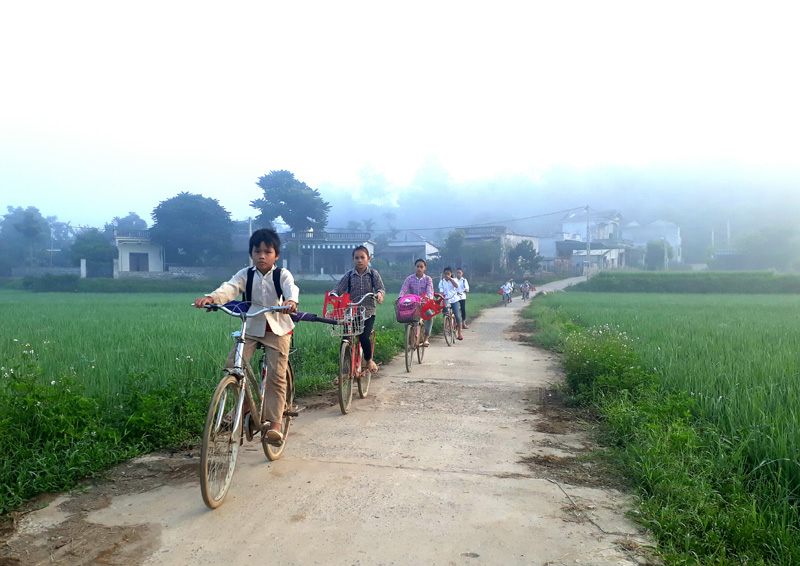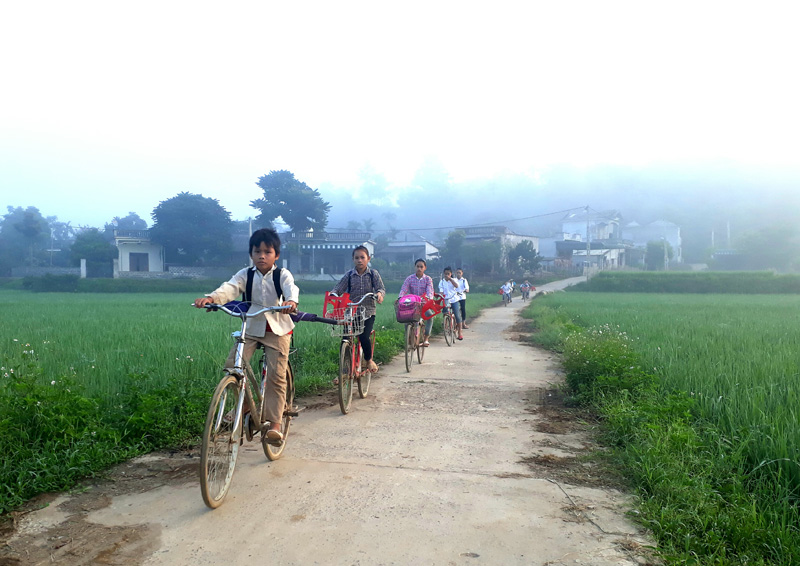
(HBO) – Away from the urban hustle, Tan Lac district in the northern mountainous province of Hoa Binh is still moving forwards on the path of reform and development. That is my own thought about the land and Muong ethnic minority people here.


A road in Chieng village, Lo Son commune - one of the
poorest communes of Tan Lac district - has been concreted to meet people's travel
need.
The though
came to me when I returned to Dich Giao, the first in Tan Lac district recognised
as a new-style rural commune, travelling on wide rural roads and crossing new schools
with full of students’ laughter.
Dich Giao was previously
known as a commune with low living conditions. Local people’s per capita income
was around 12 million VND and poor families accounted for 26 percent of the total
households in 2011.
How could such
a poor commune earn new-style rural area status four years later? Chairman of
the People’s Committee Bui Van Dinh said the determination and consensus of the
commune’s Party Organization, administration and people were the impetus behind
the success.
Residents in Dich Giao donated more than 50,000 sqm of
land for new-style rural projects as they were well aware that the new-style
rural building would lay a foundation for socio-economic development and
improving their living standards. They did not wait for support from the
government but playing an active role in the work.
The commune has set targets of maintaining and improving
19 national requirements for a new-style rural area between 2016 and 2020;
increasing per capita income to 44.2 million VND; reducing the poverty rate to
2 percent; raising the rate of trained workers to 55 percent; having 90 percent
of its population covered by health insurance and all households get access to
clean water.
Meanwhile, Quyet Chien commune is home to 360
households with over 1,640 residents but it has only
372 hectares of
farming land, including
90
hectares of rice and over
150 hectares of maize.
Most of its people are living in difficult circumstances.
The commune has taken advantages of its advantages in terms
of soil and climate to grow chayote for sale, thus help local famers improve
their living conditions.
With assistance from the Good Neighbours International
(GNI) of the
Republic of
Korea, in August last
year, local farmers zoned off 2,200 sq.m for growing clean vegetables and
fruits. The success of the project has encouraged the commune to come up with a
long-term project for off-season vegetable production by 2020. It will be a new
opportunity for Quyet Chien to develop clean agriculture and improve incomes
for local people.
Vice Chairman of the district’s People’s
Committee Bui Van Nho said the living conditions of people in 23 communes and
towns of the district may still vary but they have been improved remarkably.
With an increasingly vibrant and widespread emulation movement aimed at building cultured residential areas and cultured families, Yen Thuy District has been making steady progress toward improving both the material and spiritual well-being of its people, while fostering a civilized, prosperous, beautiful, and progressive community.
Once lacking recreational spaces and community facilities, Residential Group 2 in Quynh Lam Ward (Hoa Binh City) has recently received attention for the construction of a new, spacious, and fully equipped cultural house. The project followed the model of state support combined with public contributions in both labor and funding.
The "All people unite to build cultural life" movement, which has been effectively integrated with Kim Boi district’s socio-economic development goals, is fostering a lively spirit of emulation across local residential areas, hamlets, villages, public agencies, and enterprises. In addition, through the initiative, traditional cultural values are being preserved and promoted, while community solidarity and mutual support in poverty reduction and economic development are being strengthened.
A working delegation of the Hoa Binh provincial People’s Committee led by its Permanent Vice Chairman Nguyen Van Toan on June 11 inspected the progress of a project to build the Mo Muong Cultural Heritage Conservation Space linked to tourism services in Hop Phong commune, Cao Phong district.
Born and growing in the heroic land of Muong Dong, Dinh Thi Kieu Dung, a resident in Bo town of Kim Boi district, in her childhood was nurtured by the sweet lullabies of her grandmother and mother. These melodies deeply imprinted on her soul, becoming an inseparable part of her love for her ethnic group's culture. For over 20 years, this love for her hometown has driven Dung to research, collect, and pass down the cultural values of the Muong people to future generations.
In the final days of May, the Ethnic Art Troupe of Hoa Binh Province organized performances to serve the people in remote, mountainous, and particularly disadvantaged areas within the province. These were not just ordinary artistic shows, but they were the meaningful journeys aimed at spreading cultural values, enhancing the spiritual life of the people and contributing to the preservation of ethnic minority cultural identities.




